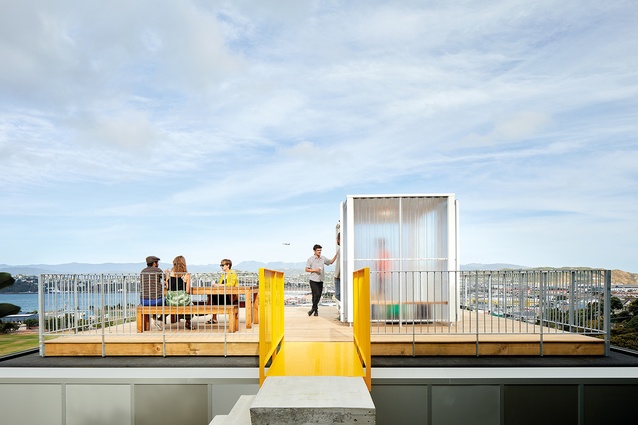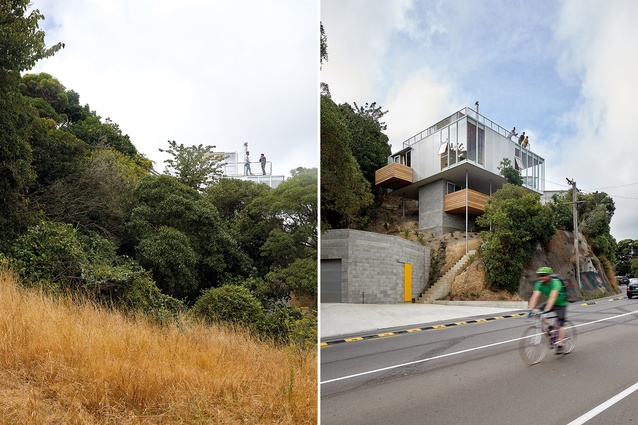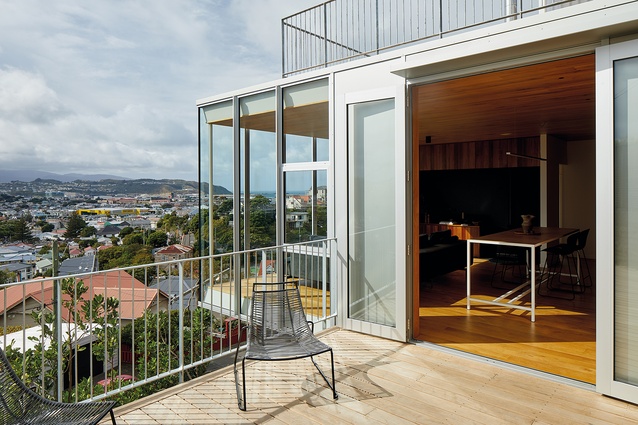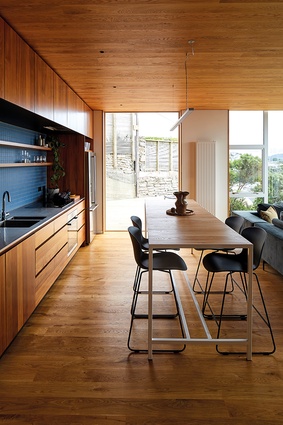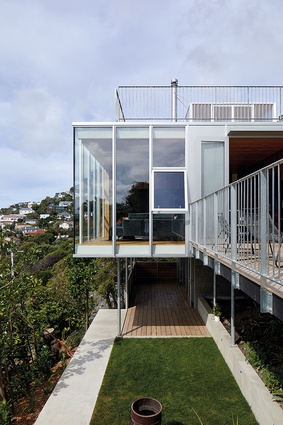Boxing clever: 10x10 House
Megan Edwards visits Patchwork Architecture’s award-winning project in Wellington and finds a playful, elegant and environmentally efficient architectural solution on a scrap of leftover hillside.
Following on from their experimental and self-built ‘Dog Box’ in 2013, Ben Mitchell-Anyon and Sally Ogle of Patchwork Architecture have made a virtue of responding to the rigours of marginal hillside sites in Wellington and the challenge of building affordably. The names of their projects have continued to be as arresting and pithy as their architecture. In schemes such as ‘Stealth Bomber’, ‘Pyramid Scheme’ and ‘Hot Box’, their practice has continued to emphasise economy – spatially, structurally, financially and environmentally – with a little wit thrown in for good measure.
In looking for a house to review that would stir me from the grooves of my own architectural practice, their ‘10x10’ project grabbed my attention: a miniature skyscraper tucked into a Wellington hill, freshly detailed and without a wasted gesture.
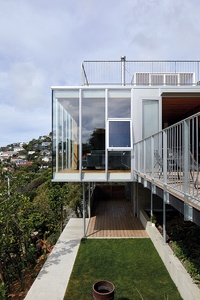
A pre-arranged trip to Wellington meant I could visit. Located on the skyline en route between city and airport, it signals the possibility of the lookout it offers to all those that pass by. This public aspect is reflected in lean, semi-commercial detailing – in-situ concrete steps, an exposed concrete block core, galvanised steel poles, curtain-wall glazing, and the witty bit: ‘hazard’ yellow paint on the garage door and steel gantry to the roof deck, along with a structure which mimics a public bus stop on the roof (while providing respite from the wind and preventing outdoor furniture from blowing away).
Usually, the tricky sites for which Patchwork designs require sloping roofs to comply with daylighting angles but this site – located adjacent to a road and a public park, and to the south of a neighbour on the high side – permitted the architects to pierce through those normal restrictions with a strong rectilinear form.
One gains access to the 10m x 10m house platform from a compact, concrete-block core, which houses stair and entry and an office for the builder-owner. The buff floor plan is ruthlessly efficient – providing three bedrooms, two bathrooms, storage and a kitchen/dining/living room. The vertical circulation is compact and elegant: the lower stairs are concrete, intermediate winders are constructed in solid Tasmanian blackwood, and the top steps are folded, self-supporting steel, their minimal depth allowing crucial head height below. To save space in the living room, they have wrested double use from an island bench as a high dining table. A lower table may have made a calmer space but the island bench, where all sit up, matches the youthful energy of the house.
In contrast to the public exterior, interior surfaces are moody and rich – oiled Tasmanian blackwood cabinetry, oak-lined ceilings and floors, and smoky-blue tiles. The comfort of the interior and the connection of the house with the hill will be enhanced as the garden develops. Meanwhile, the somewhat spare experience of these rectilinear internal spaces is offset by the changing weather conditions outside: the mutability of the outlook enjoyed from the safety of the defined cabin.

Patchwork Architecture’s go-to builder, Adam Pierson of Dorset Construction, built the project. He, along with his wife, Alicia, and daughter, were also the clients for the house. The trust between architect and builder has allowed this simple plan form to be detailed and executed with a level of rigour that elevates the project to another level. Every material junction, every connection between components has been considered, evaluated and executed with utmost precision but also with an eye towards practicality. The finished result is both elegant and pragmatic.
Materials are treated simply and with a minimum of modification: the slab and concrete blocks of the core are not painted or plastered, the slender steel poles are not painted, concrete looks like concrete, metal looks like metal and wood looks like wood.
The architects are not afraid to show how the building is made: the base plates to the elegant steel poles sit upon the concrete footing with the bolts visible, the timber deck and balustrade at the lower level wrap around the supporting steel poles but do not absorb and conceal them. It’s these deft details that make this house so legible, fresh and fun.
The clarity of the form is enhanced by extending the external skin of the building, including the windows, full-height to absorb both the lower floor structure and the roof structure and membrane roof. With no visible window head or sill, the floor and ceiling planes float. It is not that this hasn’t been done before, it is a standard feature of many multi-storey commercial buildings, but it’s not the sort of thing you expect to see in the suburbs. A consistent 900 glazing module has been continued around the building in aluminium-faced, cement sheet cladding.

The fresh look of the construction details that Sally and Ben develop in their projects is born of a desire for architectural expression and value for money. Sally has written eloquently of the experience of putting their own money on the line and physically crafting the details themselves, along with architect Tim Gittos, in the construction of their first home, the ‘Dog Box’ in Whanganui. The fruit of this hands-on experience is tangible in their projects. Tim and Ben both worked for Melling Morse Architects before their ‘Dog Box’ experience: another influence they acknowledge in their work.
Looking to the work of this younger practice is a helpful prompt in considering what kind of architecture might be relevant in this time of environmental crisis. If we are going to use resources, we need to squeeze out and spread around the return from them. An efficient, elegant 110-square-metre family home on a scrap of leftover urban hillside, which lifts the spirits of those who drive by and provides a good spot for rooftop parties, seems like a win. This project demonstrates the compelling aesthetics of a clear architectural solution and the opportunity for wit and architectural expression in the making of a building. With this exposed work, there is no space for wrong moves but I can’t see any.
10 out of 10.

